There are plenty of examples of illustrators who have defined a story visually by being the first or best illustrator to respond to it, such as Winnie the Pooh (1926) written by A A Milne and illustrated by E H Shepherd, The Gruffalo (1999) written by Julia Donaldson and illustrated by Axel Scheffler, or Little Red Riding Hood (1812) as defined by the Brothers Grimm and illustrated by Arthur Packham.
Look at some of these examples or find your own. What is it about the illustrations that links so well with the text? Is it simply familiarity, that we’ve got used to seeing these characters in this way, or is there more going on in the relationship between image and text? Pick a few examples to discuss.
Selection of Illustrators
I have selected three examples for this Research Task:
- Beatrix Potter (author and illustrator)
- Roald Dahl (author) and Quentin Blake (illustrator)
- Jacqueline Wilson (author) and Nick Sharatt (illustrator)
Beatrix Potter
Being both the author and the illustrator of her books, it is almost possible to imagine anyone other than Beatrix Potter taking on the task of bringing her characters to life. When one takes into consideration Potter’s complete devotion to drawing the natural world from when she was a young child, it is no surprise that she was able to produce such accurate and delicate illustrations.
The Tale of Peter Rabbit (1902) was originally conceived through an illustrated series of letters Potter wrote when communicating via letter with the young sons of her former governess. This demonstrates how the ideas for the stories and characters were so intricately woven into Potter’s imagination.
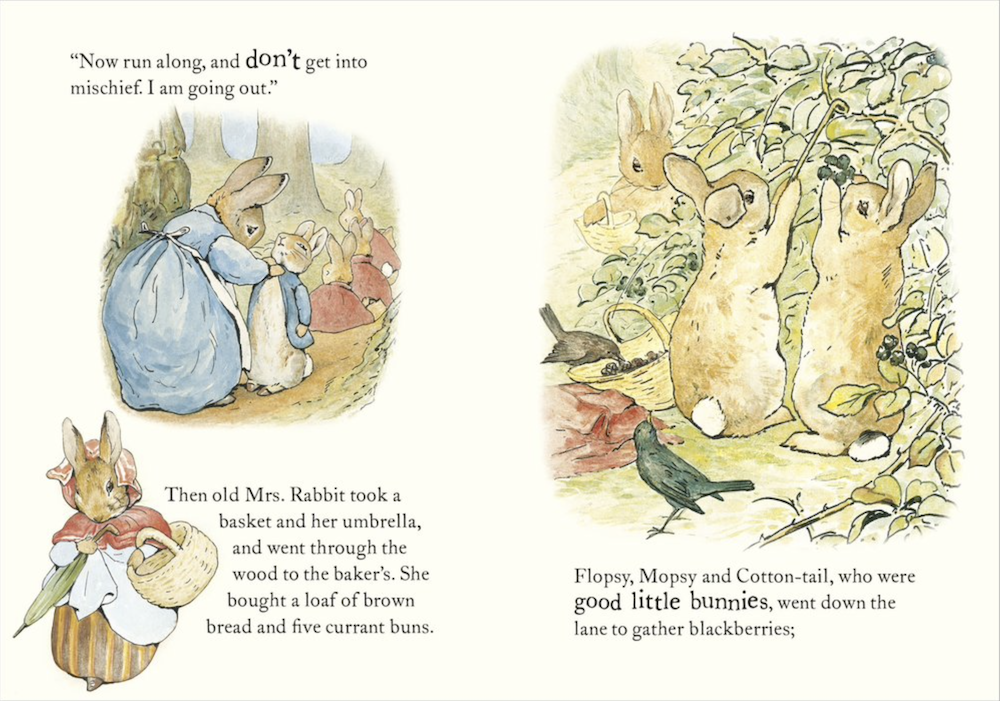
Source: Scholastic Shop.
Each small section of text is accompanied by an illustration, either in the form of a vignette or as a standalone illustration of the characters, integrated onto the white space of the book. The voice of the narrative resembles the way an adult from Potter’s time would speak to young children when telling them a story. It has a comforting, cosy tone to it, which is reflected in the style of the illustrations.
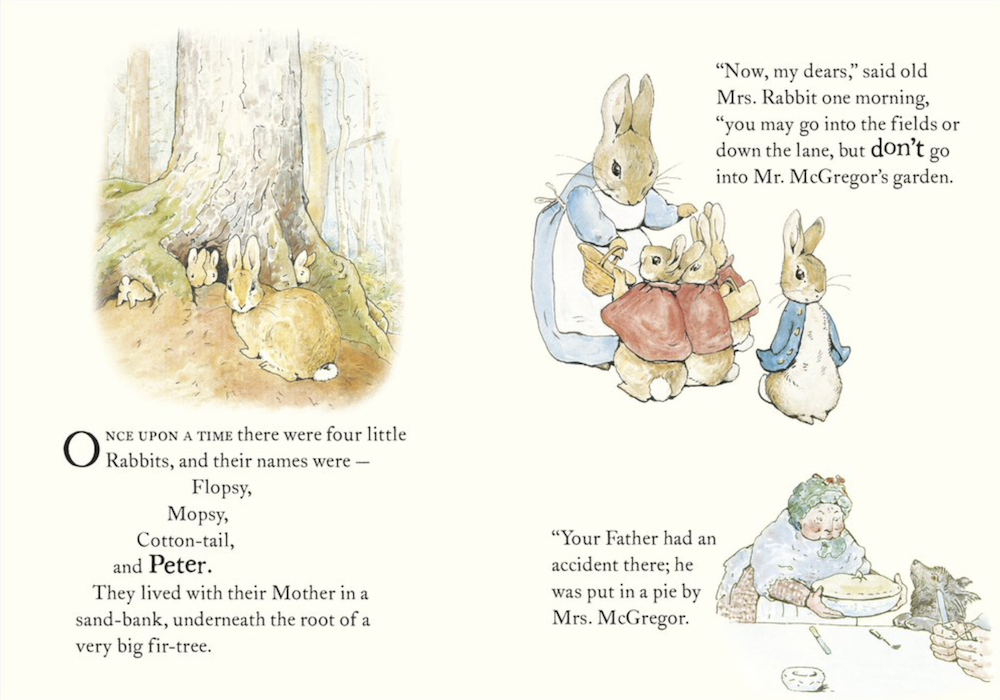
Source: Scholastic Shop.
The style of Potter’s illustrations may seem a little restrained by today’s output, but there is no denying the skill and talent she demonstrated in rendering her anthropomorphic, relatable characters that still appeal to children in the present day. Indeed, even though it is over 100 years old, The Tale of Peter Rabbit (1902) still makes a strong showing in the BBC’s 2023 list of the 100 Greatest Children’s Books. The combination of the text and the illustrations in Beatrix Potter’ books created believable scenarios where her beloved animals and nature took centre stage.
Roald Dahl and Quentin Blake
The pairing of Roald Dahl and Quentin Blake is another example whereby the text is inseparable from the illustrations. I think Dahl’s stories are so appealing to children because they are scary, funny and, occasionally, fairly disgusting! I particularly liked The Twits (1979), The BFG (1982), The Witches (1983) and Matilda (1988) when I was a child.
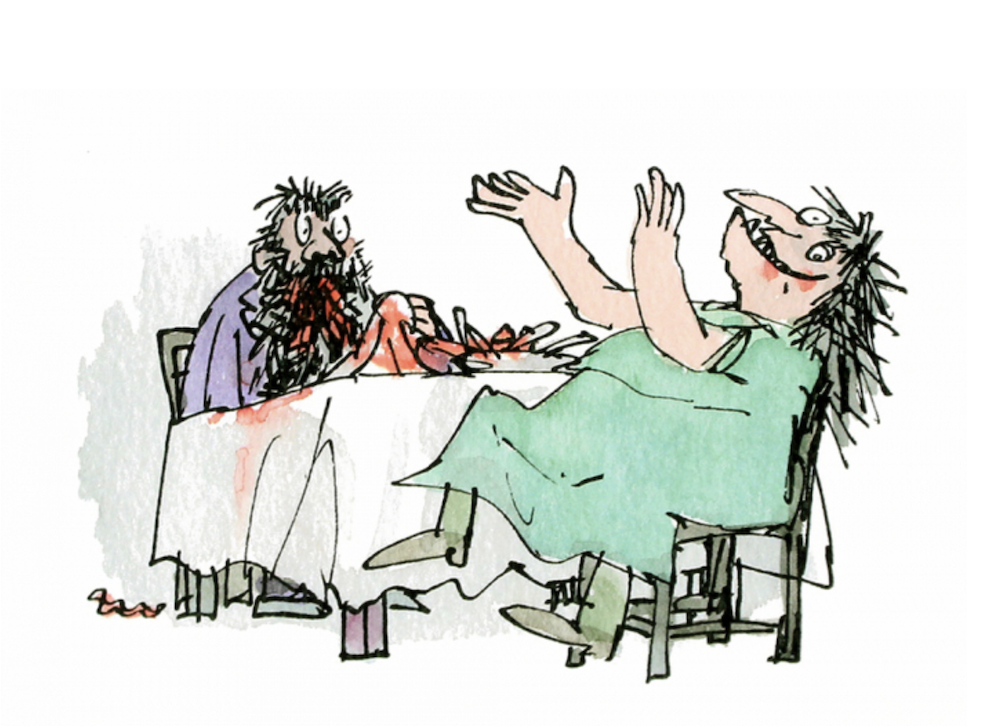
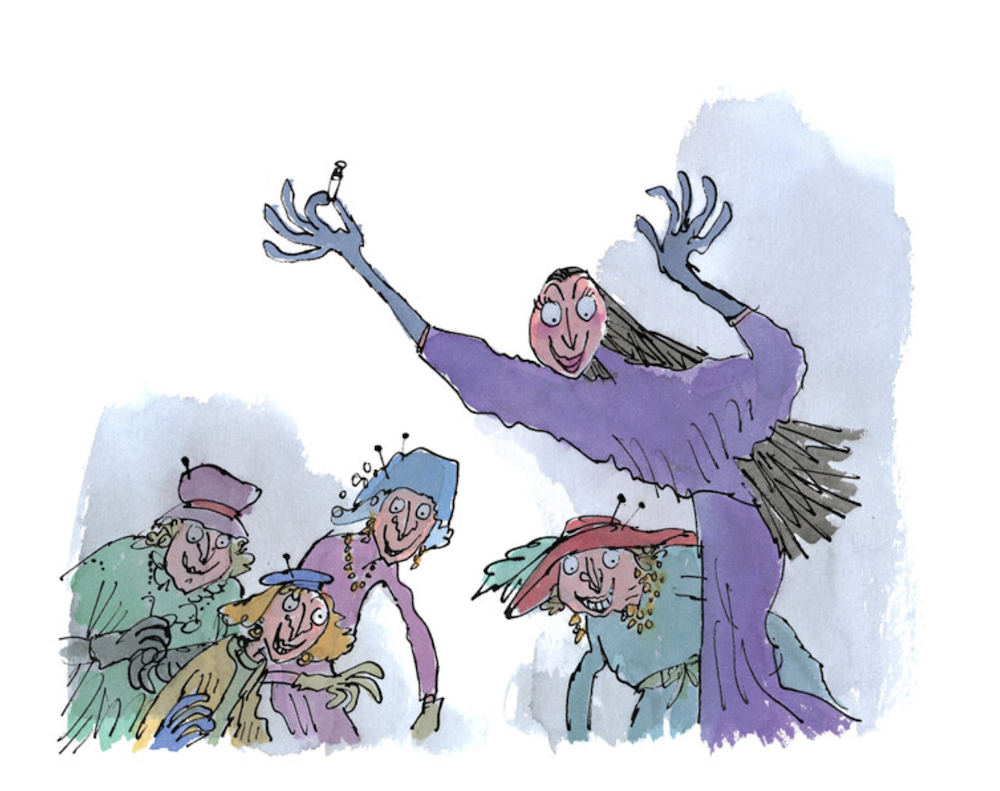
Dahl’s dark sense of humour is perfectly reflected in Blake’s illustrations of the range of often unsavoury characters whether it be a grotesque giant, a deranged headmistress or the Grand High Witch. The simple style of Blake’s sketch-like drawings is deceptive and he is able to masterfully capture a character’s personality through their expression and body language. It is as though the illustrated characters are acknowledging the reader by looking them in the eye and allowing the child to be in the story by, for example, by conspiring in a joke or being ‘threatened’ by a villain.
Jacqueline Wilson and Nick Sharratt
I was a fan of Jacqueline Wilson’s books when I was younger and Nick Sharratt’s illustrations are memorable, visual companions to the narrative. Wilson’s stories cover sensitive, challenging issues such as divorce and bullying, yet she is able to portray these scenarios from the point of view of children and young people. I have not read Wilson’s more recent books, but particular favourites of mine included Bad Girls (1996), The Illustrated Mum (1999) and The Suitcase Kid (2008).
In terms of the illustrations, Nick Sharratt draws them in quite a deceptively simplistic, cartoon style, which the age-range of the intended readers can easily identify with and comprehend. He is able to capture the essence of the characters as described in the text and depict them empathetically. They are never done in such a way that is condescending or stereotypical, which some other adults may do if tackling such issues that Wilson covers.
In the example below, taken from The Suitcase Kid, the meaning behind the illustration is so simply conveyed by the expressions, placement of the characters and their body language, that the reader has this image nestled in their mind before even starting the story. The first sentence reinforces the message of the drawing.
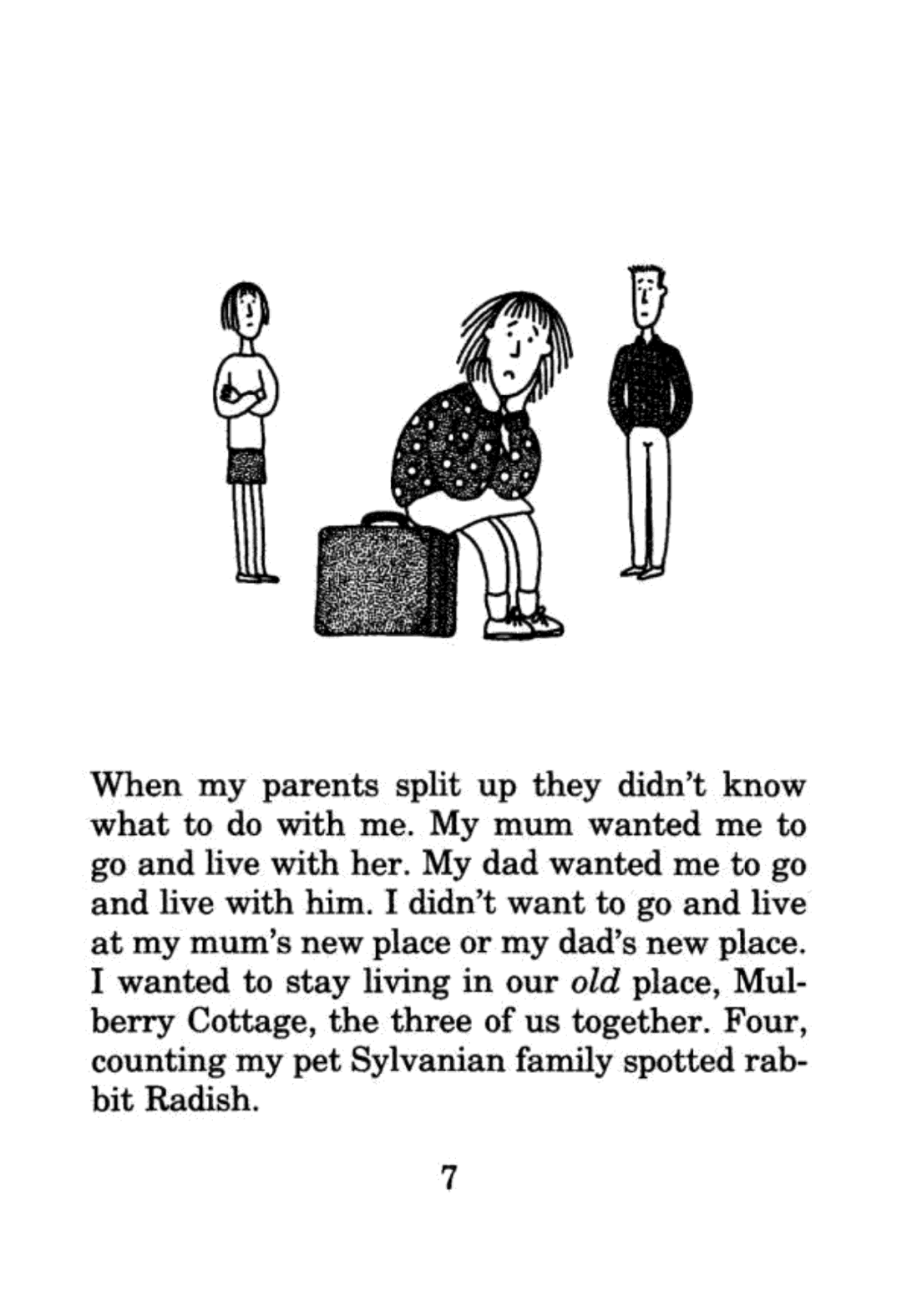
Sharratt varies how his illustrations are displayed within the pages, for example as full-page or smaller chapter heading illustrations, as well as vignettes, integrated within the text. The former setting the scene for the coming chapter, whilst the latter adds a visual accompaniment to the narrative, breaking up the blocks of text.
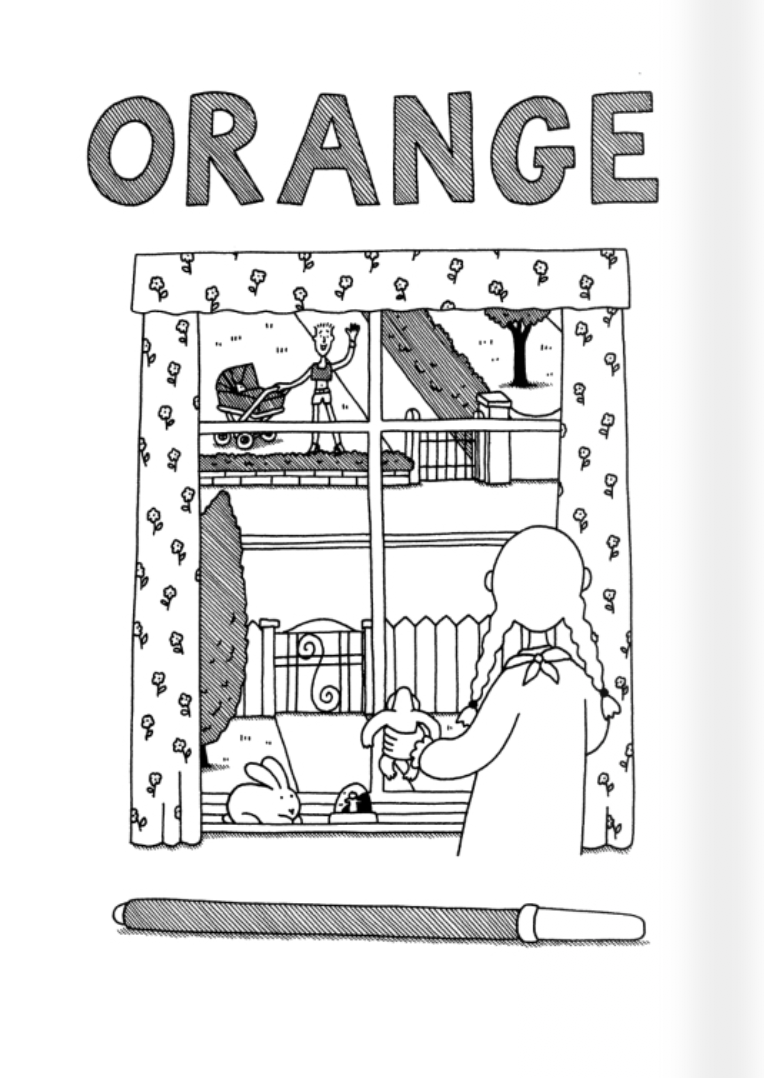
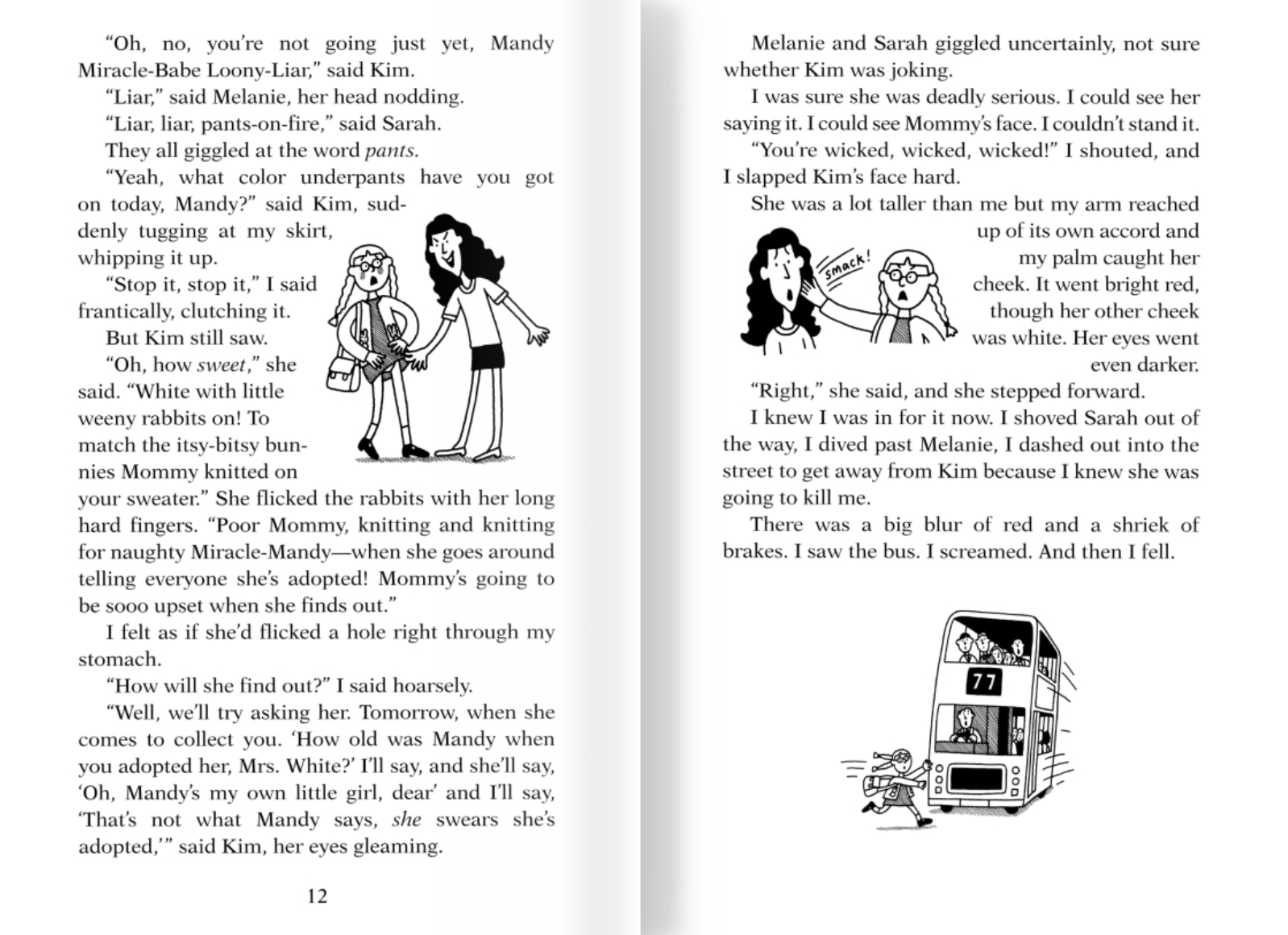
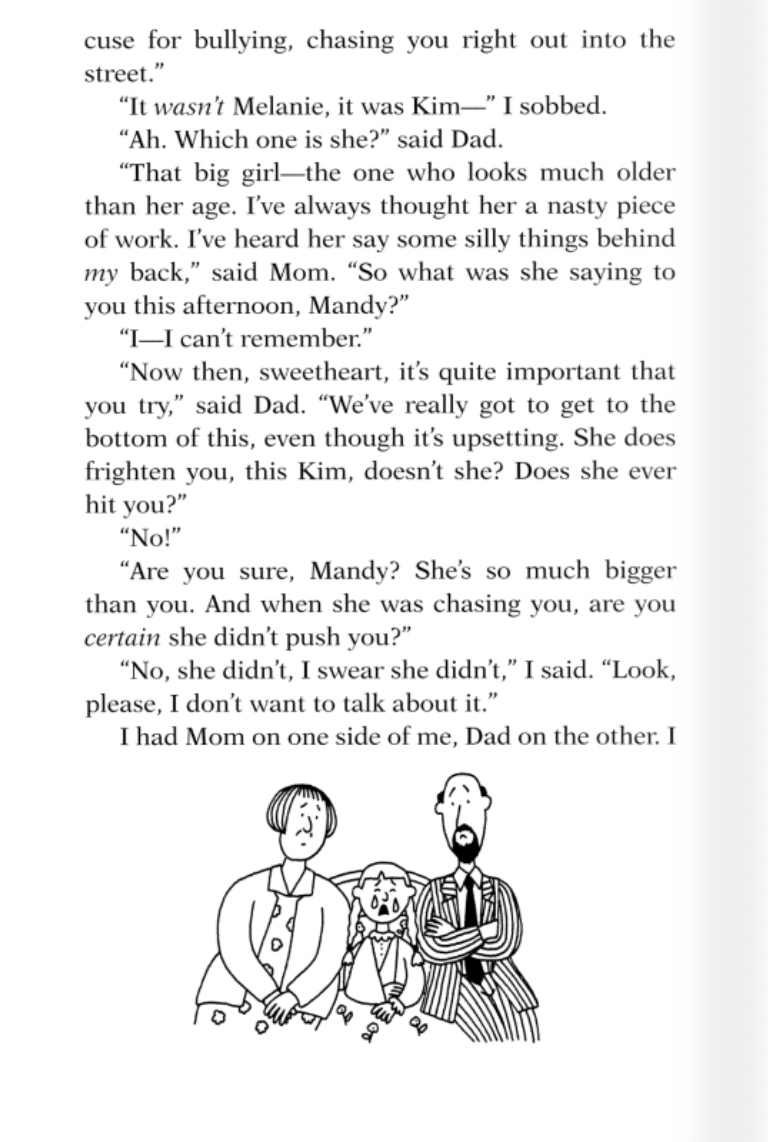
I was quite sad to discover that Nick Sharratt recently decided to end his creative relationship with Jacqueline Wilson so that he can pursue more personal work, but I will always link the two together.
Final Thoughts
I enjoyed reflecting on the relationship between the text and illustrations in children’s books. I feel some of the key points to consider, as demonstrated in the successful examples outlined above, include:
- making the images relatable and believable to children;
- communicating clearly, that is, not overcomplicating the illustration so that a child (or even an adult) is unable to interpret how it relates to the story;
- and working in harmony, not conflicting the message of the narrative with that of the illustration.
I hope that taking the time to consider how stories can be visually defined by the accompanying illustrations will assist me as I move onto the next Exercise, in which I will be tasked to attempt this myself.
Bibliography
BBC Culture (2023) The 100 greatest children’t books of all time. Available at: https://www.bbc.com/culture/article/20230522-the-100-greatest-childrens-books-of-all-time (Accessed 12 May 2023).
Google Books (n.d.) Bad Girls – Google Books. Available at: https://www.google.co.uk/books/edition/Bad_Girls/rQFKpQ93ZYwC?hl=en&gbpv=0 (Accessed 12 May 2023).
Google Books (n.d.) The Suitcase Kid – Google Books. Available at: https://www.google.co.uk/books/edition/The_Suitcase_Kid/pT7Loq9c8OcC?hl=en&gbpv=0 (Accessed 12 May 2023).
Jones, N. (2016) BBC – Quentin Blake on working with a big friendly giant. Available at: https://www.bbc.co.uk/programmes/articles/4gyMhDj7NlShWRsPnl6XXMX/quentin-blake-on-working-with-a-big-friendly-giant (Accessed 12 May 2023).
Random House Children’s Books (n.d.) Bad Girls – Author Jacqueline Wilson; Illustrated by Nick Sharratt. Available at: https://www.rhcbooks.com/books/191899/bad-girls-by-jacqueline-wilson (Accessed 12 May 2023).
Scholastic (n.d.) The Tale of Peter Rabbit – Scholastic Shop. Available at: https://eu-shop.scholastic.co.uk/products/The-Tale-of-Peter-Rabbit-Beatrix-Potter-9780723281429 (Accessed 12 May 2023).
Siddall, L. (2014) Illustration: An interview with illustrator and long-term Jacqueline Wilson collaborator, Nick Sharratt. Available at: https://www.itsnicethat.com/articles/illustration-an-interview-with-nick-sharratt (Accessed 12 May 2023).
Sturgess, F. (2020) Quentin Blake: Spend time with children? Good God, no’. Available at: https://www.theguardian.com/books/2020/feb/29/inside-the-magical-world-of-quentin-blake (Accessed 12 May 2023).
The Guardian (2014) Author Jacqueline Wilson on illustrator Nick Sherratt: ‘He got inside my head’. Available at: https://www.youtube.com/watch?v=LsFLMWlweGc (Accessed 12 May 2023).
V&A (n.d.) Introducing Beatrix Potter. Available at: https://www.vam.ac.uk/articles/introducing-beatrix-potter (Accessed 12 May 2023).
V&A (n.d.) Peter Rabbit: the tale of ‘The Tale’. Availablee at: https://www.vam.ac.uk/articles/peter-rabbit-the-tale-of-the-tale (Accessed 12 May 2023).
Wordery (n.d) Bad Girls by Jacqueline Wilson. Available at: https://www.rhcbooks.com/books/191899/bad-girls-by-jacqueline-wilson (Accessed 12 May 2023).
Yard Gallery (n.d.) Quentin Blake Prints. It Was Worms. Available at: https://www.yardgallery.com/rd-twits-worms-rd9131 (Accessed 12 May 2023).
Yard Gallery (n.d.) Quentin Blake Prints. The Witches – There Are Witches Everywhere. Available at: https://www.yardgallery.com/roald-dahl-there-are-witches-everywhere (Accessed 12 May 2023).